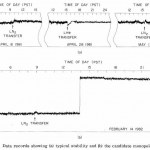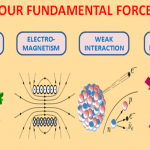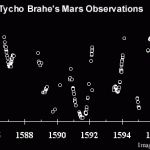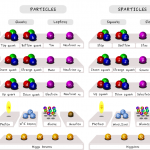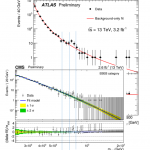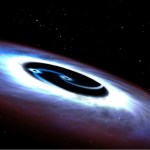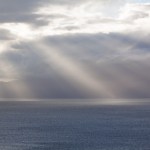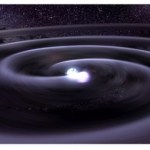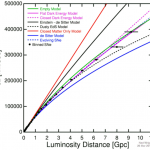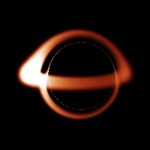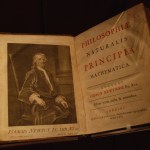Physics
“It is possible to commit no mistakes and still lose. That is not a weakness. That is life.” -Jean-Luc Picard
The laws of electromagnetism could have been incredibly different. Our Universe has two types of electric charge (positive and negative) and could have had two types of magnetic pole (north and south), but only the electric charges exist in our Universe. At a fundamental level, between electricity and magnetism, nature is not symmetric.
The electric/magnetic symmetric version of Maxwell’s equations, where both electric and magnetic sources (and currents) exist. Image credit: Ed…
"Even if there is only one possible unified theory, it is just a set of rules and equations. What is it that breathes fire into the equations and makes a universe for them to describe?" -Stephen Hawking
One of the greatest discoveries of the 20th centuries was not only that there were just four fundamental forces describing all of nature, but that two of them — the electromagnetic and the weak force — unify into a single "electroweak" force at high energies. Given the equivalences between electric charges in the strong nuclear force sector and the electroweak sector, could there be a grand…
“Philosophy of science is about as useful to scientists as ornithology is to birds.” -Richard Feynman
Writing in the New York Times on Monday, philosopher James Blachowicz argues that just as "justice" and "courage" are hard to define but easy to recognize, so science is the same way, and that there's no method to it.
Kepler’s Platonic solid model of the Solar system from Mysterium Cosmographicum (1596). Image credit: J. Kepler.
Is he right? Is science no different than poetry or philosophy in this regard? Or is the fact that only science confronts its ideas with testable evidence enough…
Periodically, some scientific celebrity from the physical sciences-- Neil deGrasse Tyson or Stephen Hawking, say-- will say something dismissive about philosophy, and kick off a big rush of articles about how dumb their remarks are, how important philosophy is, and so on. Given that this happens on a regular basis, you might wonder why it is that prominent physicists keep saying snide things about philosophy. But never fear, the New York Times is here to help, with an op-ed by James Blachowicz, an emeritus philosopher from Loyola, grandly titled There Is No Scientific Methods.
It's actually…
“All sins have their origin in a sense of inferiority otherwise called ambition.” -Cesare Pavese
We're halfway through the year at Starts With A Bang, but it feels like the greatest things are just getting started! For one, enjoy our newest podcast: on Interstellar Travel, highlighted by an interview with Larry Niven last month at Balticon 50!
As always, we've had a fantastic week leading up to right now. If you didn't catch it all, here's what you missed:
Does Earth really have a second Moon? (for Ask Ethan),
NASA's New Horizons views first distant Kuiper belt object…
“Celebrate the independence of your nation by blowing up a small part of it.” -The Simpsons
When gunpowder was first invented more than 1,000 years ago by mixing activated carbon (charcoal), sulfur and potassium nitrate together, its first major application was to the development of fireworks. By combining four simple elements – a launch, a fuse, a burst charge and ignitable stars – the most spectacular explosive shows could be produced.
The anatomy of a firework. Image credit: PBS/NOVA Online, retrieved from http://www.pbs.org/wgbh/nova/fireworks/anat_nf.html.
Yet the design of each stage…
"How well I have learned that there is no fence to sit on between heaven and hell. There is a deep, wide gulf, a chasm, and in that chasm is no place for any man." -Johnny Cash
The largest mountains, the greatest chasms, steepest cliffs and the tallest peaks on Earth are certainly impressive, particularly when compared to the scale of a human. But compared to the mountains on Mars, Io, Vesta or Iapetus, or the canyons and cliffs on Mars, Mercury, or even Charon, Earth’s features look puny.
Valles Marineris on Mars, taken by the Viking orbiters. Image credit: NASA.
How could these small…
“I have this one little saying, when things get too heavy just call me helium, the lightest known gas to man.” –Jimi Hendrix
The second lightest and second most abundant element in the Universe, helium, is incredibly rare on Earth. Practically none of the helium that Earth was formed with still exists, since was too easy for it to escape from our tenuously held atmosphere, unlike the gas giant worlds. But deep underground, in the heavy-element-rich interiors of the Earth, new helium is continuously produced.
Scientists studying the ash from a recent eruption of Ol Doinyo Lengai volcano…
"We have made the discovery of a new particle - a completely new particle - which is most probably very different from all the other particles. It's nearly a once in a lifetime experience, I would say." - Rolf-Dieter Heuer
At the end of its second, high-energy run, the Large Hadron Collider appeared to display evidence that perhaps a new particle existed at an energy of 750 GeV. The excess of twin photons produced at that energy appeared in both the ATLAS and CMS detectors, and might indicate the first particle beyond the standard model.
The Standard Model particles and their supersymmetric…
Summer continues, and the public lecture series on physics continues a pace at the Aspen Center for Physics with Dr. Catherine Heymans of the University of Edinburgh talking today on the "Dark Side of the Universe".
The talk is part of one of the three workshops currently taking place:
"Testing the Laws of Gravity with Cosmological Surveys"
"Emergence, Evolution and Effects of Black Holes in the Universe: The Next 50 Years of Black Hole Physics"
"Entanglement Matters"
the public talks are recorded and will, eventually, be available online courtesy of Aspen Grassroots TV, in the meanwhile,…
"Black holes can bang against space-time as mallets on a drum and have a very characteristic song." -Janna Levin
If you had told an astrophysicist five years ago that binary black holes were common, that would’ve been news, but not surprising. If you had told them that ~30 solar masses was a good estimate for each one of their masses, though, you might have had to pick their jaws up off the floor. Yet LIGO’s very first detection showed us exactly that, much to the surprise of many.
The inspiral and merger of the first pair of black holes ever directly observed. Image credit: B. P. Abbott et…
"The sacred rights of mankind are not to be rummaged for among old parchments or musty records. They are written, as with a sunbeam, in the whole volume of human nature, by the hand of the divinity itself; and can never be erased or obscured by mortal power." -Alexander Hamilton
Seen poking through a cloud, trees or other opaque materials, sunbeams are one of the most surprising natural phenomena, when you think about it. There’s always scattered, ambient sunlight in all directions, and the bright sunshine is never visible as a ray when there aren’t clouds.
Public domain photo from Pixabay…
The NPR program Here and Now has been running segments this week on Science in America, and one of these from yesterday featured me talking about science literacy. We had some technical difficulties getting this recorded-- it was supposed to happen at a local radio studio last week, but they had some kind of glitch, so instead we did it via Skype from my office on campus. (Where there was some sort of heavy equipment running outside my window before and after the interview, but miraculously, they took a coffee break for the crucial fifteen minutes of the actual call...)
You can listen to the…
"If you've seen one gamma-ray burst, you've seen one gamma-ray burst!" -Common quote among gamma-ray burst astronomers, emphasizing how little we know about them.
When the first gravitational wave signal ever, GW150914, was directly detected, NASA’s Fermi GBM team shocked the world by announcing the detection of a high-energy burst of electromagnetic radiation. This was a huge surprise, because merging black holes shouldn’t have a bright gamma ray or X-ray flash associated with them!
Image credit: NASA, of an inspiral and merger of two massive, compact objects; illustration only.
A…
"The new claim now is [a] boson with a mass of 16.7 MeV. But they don’t say anything about what went wrong in their previous claims and why we should not take those claims seriously." -Oscar Naviliat Cuncic
Everyone knows that the Standard Model of particle physics cannot be all there is. It does a fantastic job of describing the known particles and interactions, but many mysteries remain, including the origin of the matter-antimatter asymmetry, the existence of dark matter and dark energy, the origin of the interaction strengths of the particles, and why they have the mass values that they…
The Aspen Center for Physics organizes weekly public lectures durings its winter conferences and its summer workshops.
This week the public lecture was by Roni Harnik of Fermilab on “The Higgs Boson and the Mystery of Mass.” The lectures are videoed by Aspen Grassroots television, and archived, and are very slowly being added to the Aspen Physics youtube channel.
This winter, Prof. Andrea Ghez, UCLA gave one of the public lectures at the Wheeler Opera House in Aspen: "The Monster of the Milky Way", on the central supermassive black hole in our galaxy.
“If everything seems under control, you’re not going fast enough.” -Mario Andretti
One of the toughest things to wrap your mind around in the natural world is the idea of special relativity: the faster you move, the closer you get to the speed of light, the more difficult it becomes to increase your speed at all. While you might approach the speed of light arbitrarily and asymptotically, you’ll never reach it.
Public domain timelapse photo by flickr user comedynose (Pete), illustrating fast, relativistic motion. Image retrieved via https://www.flickr.com/photos/comedynose/23696582553.
And…
Another few weeks of physics blogging at Forbes, collected here for your convenience.
-- Commercialization Of Space: Three Cheers For The Mundane: Some belated but brief comments on the SpaceApps conference I went to down in NYC.
-- How Studying Atoms On Earth Helps Us Learn About Other Planets: As a snobby grad student in cold-atom physics, I thought of old-school spectroscopy as boring and pointless, but a recent DAMOP session showed how those classic atomic physics studies still have a lot to offer for studies of astrophysics.
-- Are The Constants Of Nature Changing, And How Can We Tell?:…
"Not only does God play dice, but... he sometimes throws them where they cannot be seen." -Stephen Hawking
The New York Times ran an article on Stephen Hawking promising there was a possible escape route from a black hole, after all. In the text, Hawking asserts,
"They are not the eternal prisons they were once thought. If you feel you are trapped in a black hole, don’t give up. There is a way out."
While it might appear that matter escapes a black hole, this is only from matter well outside of the event horizon at all times. Image credit: ESO/MPE/Marc Schartmann.
But what the actual…
"The man who views the world at 50 the same as he did at 20 has wasted 30 years of his life." -Muhammad Ali
You might not think that boxing, the sweet science, and physics, the most fundamental of all the sciences, have much in common on the surface. But look a little deeper and you'll find parallels between developing a unique skill set, solving problems, dissecting opponents and drawing the greatness out of the most difficult problems you can to increase your own glory.
Ali taunting a fallen Sonny Liston in the first round of their second fight. Image credit: AP, via http://interactives.ap…
